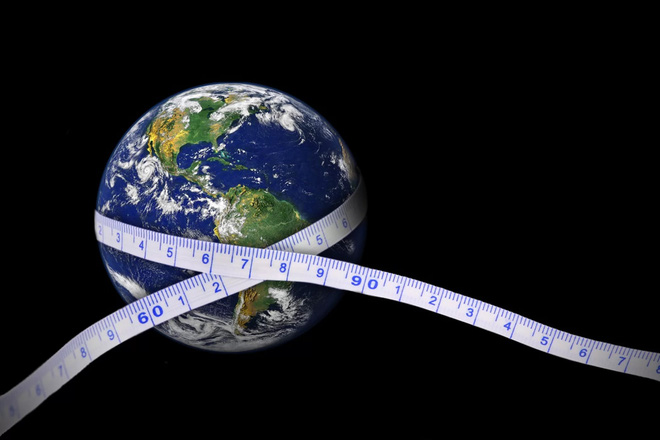Why would we not be able to fly out into space if the diameter of the Earth increased by 50%?
Unlike what you think, this idle question is the vision of human limitations in exploring the universe.
For many people, human "leaps and bounds" often mean Neil Armstrong's "small steps" on the moon's surface.
However, NASA astronaut, chemical engineer, and a learned scholar Donald Pettit disagreed. The leap, according to him, actually happened much closer to our beloved Earth house.
" Human leaps and bounds are not the first step on the moon, but the reaching of Earth orbit ," he wrote in 2012.
This first step, reaching a distance of 400km from the ground, requires half of the energy needed to reach the surface of Mars. Why does this first step need such a huge cost? That's because the Earth's Gravity is huge. And physicists have come to the conclusion that just one cent less than the necessary amount, is that Earth will 'possess' your spacecraft immediately, in a gentle way. ok
Gravity covers all populations residing on Earth, which means that 80 to 90% of the masses of existing missiles need to have a huge push to reach space! According to Pettit, this means sitting on top of a rocket even more precarious than on a barrel . gasoline. It also means there won't be much room left for food, computers, scientific experiments, and most importantly: astronauts.

Despite these disadvantages, we need to realize how fortunate we are.
" If the radius of the planet is bigger, there is a view that it is impossible to build a missile beyond space ," Pettit said.
Using Tsiolkovsky's missile equation, he showed us why there is such a view
Suppose we make a rocket with 96% propellant (4% jet) . maybe the reality is the limit of launching the device to space. Let's assume we will choose Hydro-oxygen, the most powerful chemical repulsor ever known, and is currently in common use. By including these data in the missile equation, we can convert the calculated escape force into its corresponding planetary radius. That radius will be about 9,680 kilometers (the current Earth is 6,670 kilometers).
If the diameter of the earth is about 50% large (while still keeping the current density), then we won't be able to travel the universe, at least if we use the rocket as a means of transportation.
Pettit's thinking experiment emphasizes some points as follows. First, despite being the only successful means of transporting people to outer space, they are undeniable, extremely ineffective. If possible, we need to find a new means to break the constraints of gravity. Many of them, coming directly from science fiction, are being proposed. Some have been tested.
Second, building a missile launcher on the moon sounds extremely reasonable. The Moon's escape force is only 21.3% of Earth's. While a launcher on the earth 'roars' every time it works, compared to it, a pedestal on the moon is just a mere 'moan'. Although this goal is far from being achieved, however, with the advances of 3D printing technology and current material handling, it is becoming a more and more concrete scenario.
Again and again, to make it a reality, we have to extract most of the materials needed to build a spacecraft from . the moon itself, or objects close to it like comets. small planets. Or else we could use the pure Moon as a . gas station, treating a sea of ice on its surface into a hydrogen-oxygen propellant.
In Pettit's worlds, the Earth is still gaining authoritarian control over the fate of mankind. Our "escape" effort, mainly breaking the siege of gravity, is still in its infancy, but has the potential to lead to the end result: the true freedom of mankind with the universe , in a future visible.
- Earth become smaller?
- The meteorite scene hits the earth
- Detecting meteors with high probability of hitting the Earth
- What happens if we breathe twice as much oxygen now?
- Close up of black spots on the Sun.
- ISS increased its trajectory to receive supply ships
- Correctly determine the diameter of the Sun.
- Earth temperature increased by 0.3-4.8 degrees C in this century
- The price for a flight into space increased to 21 million USD
- Space station increased to receive Soyuz train
- NASA's Spitzer telescope spotted a new galaxy
- Korea announced the image of Earth taken from space
 Van Allen's belt and evidence that the Apollo 11 mission to the Moon was myth
Van Allen's belt and evidence that the Apollo 11 mission to the Moon was myth The levels of civilization in the universe (Kardashev scale)
The levels of civilization in the universe (Kardashev scale) Today Mars, the sun and the Earth are aligned
Today Mars, the sun and the Earth are aligned The Amazon owner announced a secret plan to build a space base for thousands of people
The Amazon owner announced a secret plan to build a space base for thousands of people Amazing discovery of 4.5 billion year old alien ocean of life
Amazing discovery of 4.5 billion year old alien ocean of life  What would happen if you dug a hole through the Earth and jumped in?
What would happen if you dug a hole through the Earth and jumped in?  Chilling discovery of cosmic object that almost brought the Earth to 'apocalypse'
Chilling discovery of cosmic object that almost brought the Earth to 'apocalypse'  The Sun goes into hibernation, will the Earth usher in a new ice age?
The Sun goes into hibernation, will the Earth usher in a new ice age?  Discovery of space object powerful enough to tear apart the Earth
Discovery of space object powerful enough to tear apart the Earth  NASA to test 'pneumatic brakes' for Mars lander
NASA to test 'pneumatic brakes' for Mars lander 